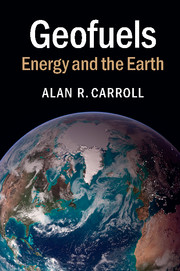Book contents
- Frontmatter
- Contents
- Acknowledgments
- 1 Introduction
- 2 The Living Earth
- 3 Warmed from Above: Solar Energy
- 4 Wind, Water, and Waves: Energy from the Fluid Earth
- 5 Covered in Green: Biofuels Basics
- 6 Fossil Farming: The Geologic Underpinnings of Biofuels
- 7 The Light of an Ancient Sun: Fossil Fuel Origins
- 8 Digging for Daylight: Coal and Oil Shale
- 9 Skimming the Cream: Conventional Oil and Gas
- 10 Stuck in the Mud: Fossil Fuels That Fail to Flow
- 11 Petrified Petroleum: Oil Sand and Gas Hydrate
- 12 Water, Water, Everywhere
- 13 Primordial Power: Geothermal and Nuclear
- 14 Out of Sight, Out of Mind: Geologic Waste Disposal
- 15 How Long Is Forever? Energy and Time
- 16 Conclusions
- Index
- References
14 - Out of Sight, Out of Mind: Geologic Waste Disposal
Published online by Cambridge University Press: 05 March 2015
- Frontmatter
- Contents
- Acknowledgments
- 1 Introduction
- 2 The Living Earth
- 3 Warmed from Above: Solar Energy
- 4 Wind, Water, and Waves: Energy from the Fluid Earth
- 5 Covered in Green: Biofuels Basics
- 6 Fossil Farming: The Geologic Underpinnings of Biofuels
- 7 The Light of an Ancient Sun: Fossil Fuel Origins
- 8 Digging for Daylight: Coal and Oil Shale
- 9 Skimming the Cream: Conventional Oil and Gas
- 10 Stuck in the Mud: Fossil Fuels That Fail to Flow
- 11 Petrified Petroleum: Oil Sand and Gas Hydrate
- 12 Water, Water, Everywhere
- 13 Primordial Power: Geothermal and Nuclear
- 14 Out of Sight, Out of Mind: Geologic Waste Disposal
- 15 How Long Is Forever? Energy and Time
- 16 Conclusions
- Index
- References
Summary
All places are alike,
And every earth is fit for burial.
Christopher Marlowe, Edward II (1594)There is something deeply satisfying about burial in the Earth. On the one hand, it can symbolize hope for the future, for example, if we sow the seeds for a new crop or bury something of value that we plan to dig up later (treasure perhaps, or a time capsule). On the other hand, burial is wonderfully effective for concealing that which we wish to permanently forget, such as the inevitable decay of our deceased relatives or the mountains of household trash we produce every day. The former we reverently inter in cemeteries; the latter we dump unceremoniously into landfills. The net result is the same in both cases, however; a problem has been eliminated and we can move on with our lives.
It is tempting to believe that energy wastes can be eliminated the same way, and perhaps they can. Saline water (brine) that has been produced together with crude oil or natural gas has been routinely re injected into deep disposal wells for decades. If released untreated at the surface, subsurface brines can harm vegetation, wildlife, and livestock and contaminate freshwater supplies. Returning them to their point of origin provides an expedient, low-cost solution that generally causes little trouble. In a relatively small percentage of cases this solution may create new problems of its own, however, if high-pressure fluid injection unlocks previously stable earthquake faults.
Burial might also be used to dispose of unwanted CO2, to limit its buildup in the atmosphere. While not yet routine, this approach is currently being tested at various sites worldwide. Ironically, one of the main challenges is obtaining large volumes of concentrated CO2 to bury. Its concentration in the atmosphere is very small, currently about 400 parts per million. We would like to bury just CO2 and leave the rest of the atmosphere where it is, but separating the two would be very expensive.
- Type
- Chapter
- Information
- GeofuelsEnergy and the Earth, pp. 287 - 313Publisher: Cambridge University PressPrint publication year: 2015



